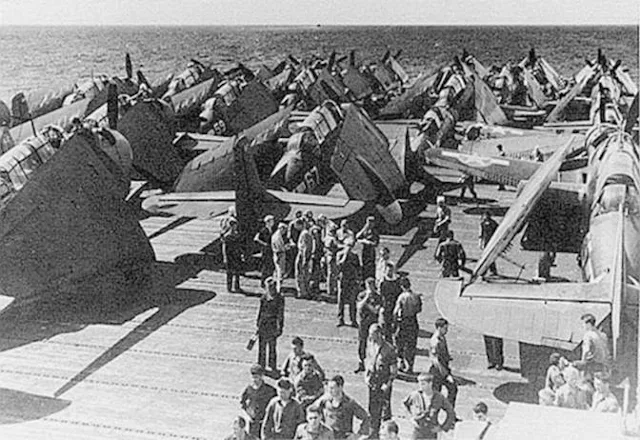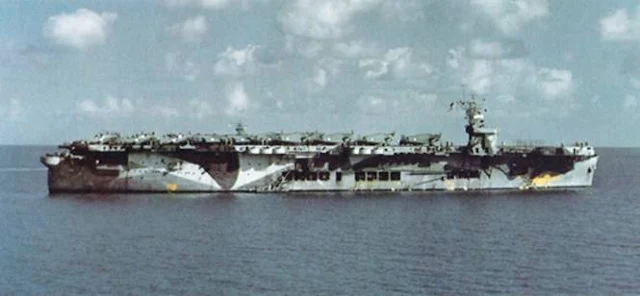 |
| A TBF Avenger operating out of Henderson Field, Guadalcanal, probably around August or September 1942. |
 |
| HVAR “Holy Moses” rockets under a wing of a TBF Avenger. |
 |
| Loading bomb into a Marine TBF, Torokina Airstrip, 1944. |
 |
| Getting ready for a mission. |
 |
| Loading bombs on a Avenger. |
 |
| Grumman TBF Avenger. |
 |
| Torpedo launch. |
 |
| Torpedo launch. |
 |
| Grumman XTBF-3 Avenger, Bureau number 24341, in three-tone scheme, at NAS Patuxent River, Maryland, on 8 June 1945. |
 |
| Grumman TBF Avenger torpedo bomber in flight over the sea. |
 |
| Grumman TBF Avenger. |
 |
| Grumman TBF Avenger torpedo bomber begins its take-off from an aircraft carrier. |
 |
| General Motors TBM Avenger, N7835C, at civilian airport circa 1970s. |
 |
| A Royal Navy Grumman Avenger Mk.II from 849 Naval Air Squadron based on the aircraft carrier HMS Victorious (R38), flying over an island in the Indian Ocean, circa 1944. |
 |
| Formation of TBM-1 Avengers on a training flight from NAS Barbers Point, Oahu, Hawaii, early 1943. Note the mixture of U.S. national insignia. |
 |
| This is a small part of Task Force 58’s striking force on its way to attack Hollandia. At left and top right are Douglas SBD Dauntlesses and at lower right Grumman TBF Avengers. |
 |
| Grumman XTBF-1 Avenger. |
 |
| Grumman TBF Avenger, “V34.” |
 |
| TBF Avenger being positioned on flight deck of Enterprise as another is brought up on the elevator, May 1944. |
 |
| Avengers warming on Enterprise’s flight deck, May 1944. |
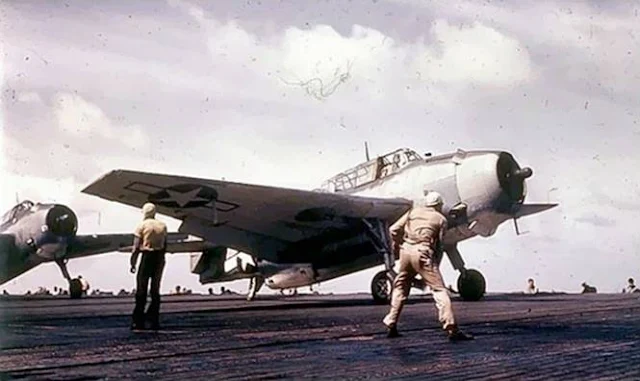 |
| Grumman TBF Avengers take off from an aircraft carrier. |
 |
| Grumman TBF Avengers, “T-43” in foreground. |
 |
| Grumman TBF Avenger being loaded with a torpedo. |
 |
| Grumman TBM Avengers over Okinawa beachhead. |
 |
| Grumman TBF Avengers. Note different national markings. |
 |
| Avenger cockpit. |
 |
| A Royal Navy Grumman Avenger Mk.II (serial JZ 444) from 820 Naval Air Squadron, going over the edge of the deck of the aircraft carrier HMS Indefatigable (R10), in 1945. |
 |
| A Royal Navy Grumman Avenger Mk.II (serial JZ 578) from 849 Naval Air Squadron, after crashing on the aircraft carrier HMS Victorious (R38), in 1945. |
 |
| TBF Avengers patrolling the skies over the Marshall Islands, 1944. |
 |
| TBF-1 Avengers of Torpedo Squadron 10 from USS Enterprise fly in formation over Espiritu Santo, March 1943. |
 |
| Interior view of the ventral gun position of a TBM Avenger, 1942. |
 |
| Saratoga underway at sea, circa 1942, with 5 Grumman F4F fighters, 6 Douglas SBD scout bombers, and 1 Grumman TBF torpedo bomber on the flight deck. |
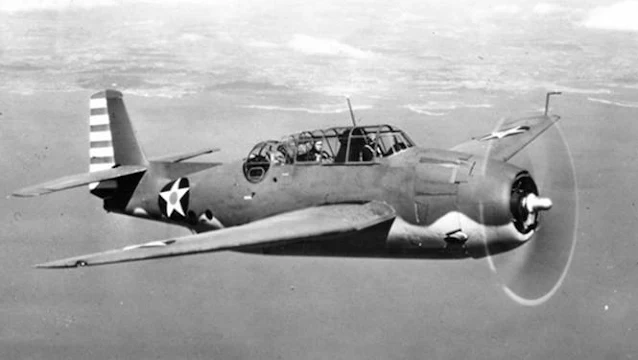 |
| Grumman TBF-1C Avenger in flight, Jan-May 1942, location unknown. |
 |
| Grumman TBF-1C Avenger in flight, January-May 1942, location unknown. |
 |
| TBF-1 Avenger making a practice drop of a Mark XIII torpedo off Virginia, United States, 3 Jul 1942. This drop was made from 125 feet at 125 knots. |
 |
| The USS Enterprise conducted flight training when steaming from Hawaii to Tonga on 23 Jul 1942. Here, upon landing, a TBF Avenger slid off the flight deck into the catwalks; no injuries. |
 |
| A training flight of TBF-1 Avengers lining up to drop practice torpedoes, late 1942, off the east coast of the United States. |
 |
| A training flight of TBF-1 Avengers lining up to drop practice torpedoes, late 1942, off the east coast of the United States. |
 |
| A training flight of TBF-1 Avengers lining up to drop practice torpedoes, late 1942, off the east coast of the United States. |
 |
| A training flight of TBF-1 Avengers lining up to drop practice torpedoes, late 1942, off the east coast of the United States. |
 |
| TBF Avenger torpedo bombers flying in formation above Norfolk, Virginia, United States, September 1942. |
 |
| TBF-1 Avenger of Marine Squadron VMSB-131 at Guadalcanal, 1942. |
 |
| TBF-1 Avenger of Marine Squadron VMSB-131 at Guadalcanal, 1942. |
 |
| An SNJ Texan, an F4F Wildcat, and a TBF-1 Avenger tied down on the flight deck of the training aircraft carrier USS Wolverine on Lake Michigan, United States, 1943. |
 |
| F6F-3 Hellcat fighters on the flight deck of Saratoga as a TBM Avenger approached to land, circa 1943-44. |
 |
| Grumman TBF-1 Avenger being tended to by carrier-based maintenance personnel, 1943. |
 |
| TBF-1 Avengers on the flight deck of USS Ranger while a K-class Airship flies overhead on anti-submarine watch, 1943. |
 |
| The Landing Signal Officer watches just before a TBF-1 Avenger traps aboard the training aircraft carrier USS Wolverine on Lake Michigan, United States, 1943. |
 |
| A training flight of TBM-1C Avengers based in Ft Lauderdale, Florida, January 1943. |
 |
| TBF-1 Avengers from the Carrier USS Essex dropping a practice torpedo from 150-200 feet, Gulf of Paria, Trinidad, 30 Mar 1943. Note the porpoising early Mark XIII torpedo. |
 |
| Avengers over the USS Belleau Wood (CVL-24). |
 |
| Loading bombs into an Avenger. |
 |
| Loading a bomb into an Avenger. |
 |
| TBM VT-15 1944-45. |
 |
| VC-93 crew H Foster (Pilot), S Orlowski (Gunner) and ARM/1c Roger W. Goodwin, 1945. |
 |
| Flight crews of VC-93 with TBM. |
 |
| Torpedo Squadron VT-10 crew, Gruebel, Nelson, and Livingston, USS Enterprise 1944. |
 |
| TBF pilot Lt Chuck Anderson and crew, VC-7, USS Manila Bay. |
 |
| TBF Pilots, “Flight 384”, 1945. |
 |
| ‘Buzzard Brigade’ pilots and aircrewmen of Torpedo Squadron VT-10, Maui, 1943. |
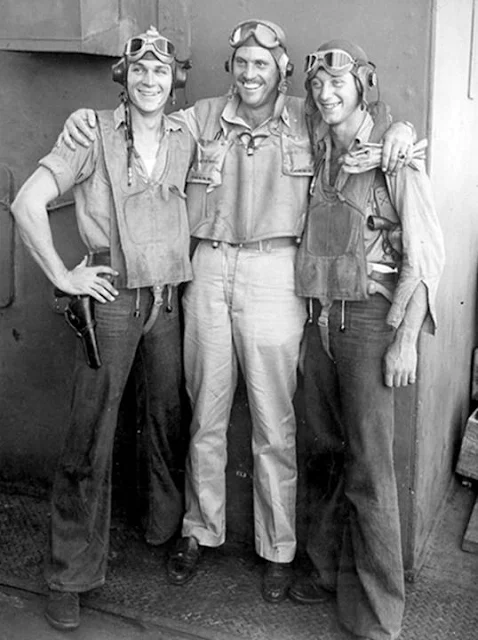 |
| VT-10 crew of Williams, Lt CMDR William Martin, and Hargrove, USS Enterprise, 1944. |
 |
| Lieutenant Commander Richard Upson TBF pilot of VT-5 ‘Torpcats’. |
 |
| TBF pilots, Lt John Chambers and other “Flight 380 Officers”, 26 March 1945. |
 |
| Lt John Chambers and Torpedo Flight “8”, Fort Lauderdale, 1 October 1943. |
 |
| TBM pilot and crew, USS Bunker Hill, 1945. |
 |
| TBF-1C battle damage, 1944. |
 |
| VT-80 pilot Lieutenant J. M. Stubblebine boarding a TBM, 1944. |
 |
| Group of VT-32 gunners and radio operators, Charlestown Rhode Island, 1943. |
 |
| Ensign R.K. Rountree, a TBF Pilot, April 1944. |
 |
| This sailor never dreamed he’d be a tailor on airplanes when he went to sea in an escort carrier, but here he is shown repairing damage to a wing section on a Wildcat plane. Released April 30, 1944. |
 |
| Baby flat Top – the Navy’s Child Prodigy. With parachute, binoculars and lifebelt, the gunner and radioman stand by to take their places in a torpedo bomber about to fly off an escort carrier. |
 |
| Baby Flattop the Navy’s Child Prodigy – Nothing is left to chance on an escort carrier’s flight deck. Once a plane has landed, many a stout line is used to lash planes securely to the ship. |
 |
| Grumman TBF Avenger pilots, 1943. |
 |
| Commander Howard H Caldwell Commander of Air Group 12, 1943. |
 |
| Lieutenant Van Mason, Executive Officer of Torpedo Squadron VT-10. |
 |
| 2nd Lt Carlton Compher of VMTB-233 with TBM-3, USS Block Island, 5 June 1945. |
 |
| Lieutenant Commander William I. Martin, CO of VT-10, 1943. |
 |
| VT-20 crew, ARM 1/c W. A. Mitts, Lt J. R. Manown Jr. and AOM 1/c A. Dipetta, 1944. |
 |
| Loading bombs in an Royal Navy Avenger. |
 |
| Crash test of the XTBM prototype, 1946. |
 |
| Crash test of the XTBM prototype, 1946. |




